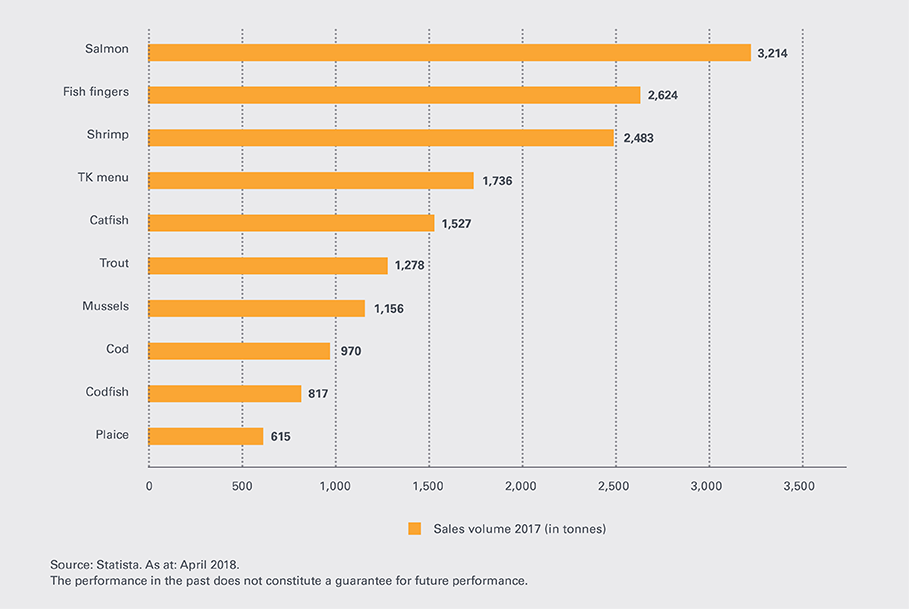Permanent place on the menu
For many people, salmon is now an essential part of their culinary experience. The pinkish meat of the fish can be used in the preparation of a wide variety of dishes, from a finely marinaded tartar steak through grilled fillet to pasta, to mention just three examples. It's hardly surprising, then, that salmon dominates the fish market in Switzerland, with retailers selling more than 3,200 tonnes in 2017. In second place came fish fingers, of which salmon generally makes up around two thirds (see graphic). Enthusiasm for salmon is not confined to the Swiss Confederation, however: its consumption is rising steadily across the globe. One of the central drivers is the sharp growth in the world's population. While some 7.6 billion people live on the planet at present, their number, according to United Nations estimates, could climb to almost 9.8 billion by 2050 – an increase of just under 30%.
Meat on the march
Among the central challenges arising from this projection is how to satisfy the demand for protein. Seen in global terms, this vital nutrient is at present primarily ingested through plants such as soya or beans. Nevertheless, more and more people can now afford to eat meat. For the moment they are still reaching predominantly for pork, poultry and beef – according to calculations by the world food organisation, the FAO, more than 300 tonnes of these three types of meat were produced in 2017. For a variety of reasons, however, production on land is now reaching its limits. As well as the limited amount of space, the enormous water and animal feed consumption is another contributory factor. A possible solution to the problem could lie in the world's oceans. Although water covers about 70% of the surface of the earth, despite growing sales figures the catch of wild and farmed salmon last year amounted to only 3 million tonnes. Overall, only 5% of the protein ingested by humans comes from the sea. Yet salmon in particular is regarded as a real “protein machine”. View more information on investment solutions on the topic “Norwegian farmed salmon: a tasty treat for consumers and investors”.
Efficient source of protein
The Norwegian fish farm operator Marine Harvest puts what is known as the protein retention for farmed salmon at 31%. This means that almost a third of the protein contained in the food is retained in the fish. According to the company, salmon thus performs much better than poultry, pork and beef. This advantage can also be expressed in the energy retention. This key ratio indicates the amount of energy, expressed in Kcal, recovered from that put into the animal through its food. The main reason why the conversion of protein and energy to body muscle and weight is so efficient is because salmon are cold-blooded “and therefore do not have to use energy to heat their bodies”, write the authors of the “Salmon Industry Handbook 2018” published by Marine Harvest. The company also puts forward the argument of climate-friendly production and points to the CO2 footprint and water consumption (see table). The sector is not free of problems, though: in July, for instance, thousands of salmon in a Chilean farm operated by Marine Harvest escaped into the wild, with unforeseeable consequences for other species.
Huge demand for salmon shares
The South American country is the world's second largest producer of Atlantic salmon, the most important species of salmon. Out in front is Norway. The fish industry is of central importance for the Scandinavians: it is the second biggest export sector of the country after the oil and gas industry. The industry’s representatives have a commensurate presence on the Oslo stock exchange. One in five of the 25 shares in total included in the lead index, the OBX, comes from the fishing industry. Of these, Marine Harvest dominates. With a market value equivalent to CHF 11.1 billion, the world’s largest fish farmer is one of the index heavyweights. Marine Harvest reached a new all-time high at the start of the 3rd quarter, which shows that salmon is in huge demand not just from gourmets and proponents of a healthy diet. More and more investors are getting a taste for it.
Sales volumes of fish products in the Swiss retail trade in 2017 (in tonnes)

Different protein sources in comparison
|
Atlantic salmon |
Poultry |
Pork |
Beef |
| Protein retention |
31% |
21% |
18% |
15% |
| Energy retention |
23% |
10% |
14% |
27% |
| Edible meat per 100 kg of feed |
61 kg |
21 kg |
17 kg |
4-10 kg |
| CO2 footprint: kg CO2 per kg of edible meat |
2.9 |
2.7 |
5.9 |
30 |
| Water consumption: Litres per kg of edible meat |
2,000 |
4,300 |
6,000 |
15,400 |
Source: Marine Harvest “Salmon Industry Handbook 2018”
VIEW MORE information on investment solutions on the topic “Norwegian farmed salmon: a tasty treat for consumers and investors”.